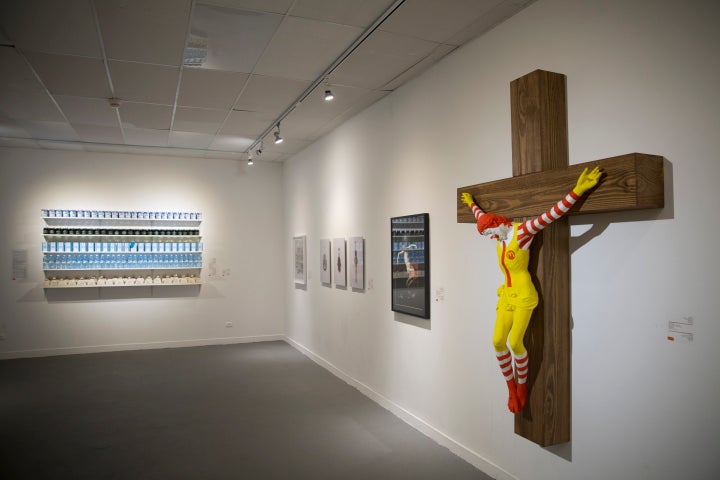
An Israel art museum’s exhibition featuring a crucified Ronald McDonald is receiving backlash from local Christians ― while the sculpture’s creator wants it taken down for a completely different reason.
Finnish artist Jani Leinonen’s sculpture, titled, “McJesus,” portrays the fast-food chain McDonald’s clown mascot hanging on a cross, his body positioned in a way that evokes traditional images of Jesus Christ on a cross. It was reportedly meant to serve as commentary on the entanglement of “religious systems and the consumer culture,” according to the Haifa Museum of Art in Israel, where it is currently on display as part of an exhibition titled “Sacred Goods.”

But some members of Israel’s Arab Christian minority see the sculpture as a disrespectful parody of their faith.
“We need to understand that freedom of expression is interpreted in different ways in different societies,” Wadie Abu Nassar, an adviser to church leaders in Israel told the Associated Press. “If this work was directed against non-Christians, the world would be turned upside down.”
Protesters gathered outside the Haifa Museum of Art last week to demand the sculpture’s removal. Israeli police told the AP that some protesters threw stones that injured three officers. Police reportedly fired tear gas at people and used stun grenades.
On Monday, representatives for Christian churches in the region appeared at a district court to lodge complaints about the exhibition. They are seeking a court order to have the sculpture removed, the Times of Israel reported.
A Catholic leader in Haifa told the Israeli newspaper Haaretz that his church condemns violent protests around the artwork and supports the artist’s critique of capitalism — but not through the defacement of the crucifix.
“We denounce the exhibition and the injury to the holiest symbol of Christianity by an institution that is supposed to serve citizens of all religions,” the Rev. Archimandrite Agapious Abu Sa’ada of Haifa’s Saint Elijah Cathedral told Haaretz.
The 40-year-old artist behind the sculpture is also demanding its removal. Leinonen told the Israeli broadcaster Keshet on Sunday that he had joined the Boycott, Divestment and Sanctions movement (BDS), a campaign that seeks to get Israel to change its policies towards the Palestinians. Supporters of the controversial movement say it is meant to peacefully promote Palestinian political and civil rights by pressuring Israel into ending its occupation of the West Bank, granting Palestinian citizens of Israel full equality under the law, and giving Palestinian refugees a right of return. Opponents say BDS is an anti-Semitic effort to delegitimize Israel.
Leinonen said he asked the Haifa Museum of Art to remove the artwork from its exhibition and was surprised to hear that it was still up.
“That annoyed me very much since the exhibit is displayed in the exhibition against my will,” he told Keshet, according to a translation by The Times of Israel.
The Haifa Museum told Keshet that the McJesus sculpture was borrowed from a Finnish gallery as part of a contract and that it hasn’t received a request to remove it, the Times of Israel reported.
Leinonen has also created alternative crucifixes that feature the Trix cereal’s rabbit mascot, Kellogg’s Corn Flakes’ Cornelius Rooster, and the maid that appears on boxes of a Finnish cereal brand.
In addition to the McJesus sculpture, the “Sacred Goods” exhibit also features artwork depicting a crucified Jesus carrying shopping bags and wearing sneakers, and a “Ken Jesus Christ” ― a piece that reimagines Christ as a smiling Barbie doll.
The museum’s director Nissim Tal said the exhibit has been on display for several months without incident. The backlash bubbled up after some of the artwork was shared on social media, the AP reported.
Tal told the AP the museum doesn’t plan to take the McJesus statue down. In response to the protests, the museum placed a curtain over the exhibit’s entrance that blocks it from general view and posted a sign warning visitors about potentially offensive content.
“This is the maximum that we can do,” Tal said. “If we take the art down, the next day we’ll have politicians demanding we take other things down, and we’ll end up only with colorful pictures of flowers in the museum.”